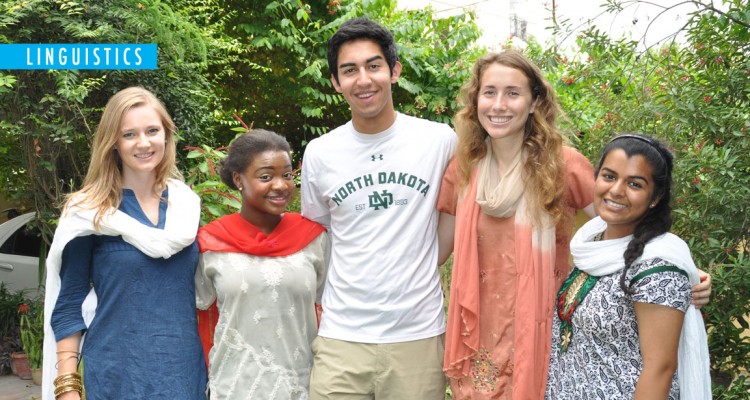By Kakul Hai
They came with an eagerness to learn the Urdu language, but they left with a heart filled with immense love for everything Indian and Lakhnawi!
Amon Rizvi, a student of journalism, is a Pakistani-American who hails from Chicago, Illinois. Amon’s decision to learn Urdu is based on her career-choice as she wants to work as a journalist and in the South Asia region, focusing mainly on India and Pakistan.
She feels that in order to earn people’s confidence in her journalistic abilities while working in this region she is more likely to be trusted if she speaks the language of the people. “Also, I have a family history with the language, so I thought it would be beneficial for me to learn the language, instead of relying on a translator.”
Even though Amon’s parents speak Urdu at home, she felt the need to take a course in Urdu that would teach her how to read and write Urdu fluently, in a way she was not able to learn at home. Not finding any Urdu-teaching schools or programmes in the Midwest in the United States, Amon headed for Lucknow, painstakingly learning to read and write Urdu in an intensive three-month Urdu course offered by American Institute of Indian Studies (AIIS).
Emphasising the similarity between India and Pakistan, Amon says, “My family is from Karachi. My mom was visiting Pakistan during the first month that I was here, so I used to tell her that Ammi, “it’s the same.” The minute I landed in New Delhi, it felt just like Karachi. It all smells the same, it all feels the same. There are some differences, but a lot of times, it’s just so similar. I feel like I’m in Pakistan half of the time!”
The big wall of mistrust, separating India from Pakistan, is more or less an illusion, it seems! Young people like Amon can act as agents of change, breaking the fabricated barriers between the neighbouring countries, bound together by the common thread of a shared historical past. Especially since such barriers do not exist when young people from these two countries meet in another place, Chicago, for instance.
“So when two people meet in Chicago, they’re very excited ‘you’re from India? I’m from Pakistan! That’s so great, we have so much to talk about, since our cultures are so similar!’” says Amon. “I mean, I would have been Indian if my grandparents hadn’t left (during Partition),” she claims, pointing out what a close call it was, of almost having an Indian identity.
Muneeb Hyder echoes the same sentiments. Born to a Pakistani father and American mother, he too felt, for the most part, that he was in Pakistan during his two-month stay in India. “I’ve spent half of my life in Pakistan, so I definitely got that vibe. I’ve yet to find a major difference, apart from seeing the mandirs that are not a common sight in Pakistan,” he says.
Hailing from North Dakota, Muneeb is studying aviation business and also hopes to “end up in the region (South Asia) at some point,” which is the reason he is learning Urdu “since Urdu, and Hindi, have such a large influence in the South Asia region.”
Ada Rauch is from Los Angeles, California, studying history in New Jersey. Ada had previously spent a year in Varanasi, working for an NGO in 2012, where she lived with a host family and learnt Hindi. Once back in New Jersey, she wanted to keep up with the language, and also learn Urdu, a language she was introduced to by one of her teachers who hailed from Lucknow.
“I started learning Urdu at school in New Jersey, and then I found out about this program (at AIIS) and I wanted to get better at speaking Urdu, so I decided to come here, and it has helped a lot,” she says.
She doesn’t know quite yet how she would use the Urdu language in her life or career, for now she is learning the language because she is interested in linguistics and likes to be able to talk to different people who speak different languages.
“After school I want to do something that has to do with international issues and with helping people, and I hope that Urdu can help me in some way to do that,” she adds.
“Also, Urdu is like a bridge language, since it’s so similar to Hindi and Farsi, and I plan to learn Farsi next year, so I’m hoping Urdu will help me in that as well,” Ada tells us.
Tiana Cherry, an international law student with a focus on helping refugees re-settle in the US, is from Dallas, Texas. A beginner in Urdu, she is learning the language because she loves to learn about new cultures. Tiana has an interesting story about her introduction to the Urdu language.
“A few of my friends in Washington DC spoke Urdu, and for a long time they did not tell me what language it was that they were speaking! They only opened up to me about their cultural background once I had gotten close to them, which I thought was interesting and which ignited my interest in learning about new cultures when I realised that lack of knowledge of different cultures prevents people from opening up to people from different cultures.”
She further realised the need to learn Urdu when she made some policy recommendations on the Middle East at a conference in the USA. “I realised I needed to learn the language of the region in order to work on issues related to the Middle East and South Asia, and help the people there,” Tiana explains.
A native of Stockholm, Sweden, Marielle Velander has lived around the world. She has recently completed her undergraduate studies in international affairs and anthropology, with a minor in Arabic studies, and is preparing to begin her graduate studies in anthropology and development management at the London School of Economics, England.
Marielle’s fondness for the South Asian region dates back to her childhood. Her favourite books were set in India and Pakistan, and in high school, she even wrote a research paper on the Partition. “I’ve always been fascinated by the culture, religion, and political dynamics (of the South Asian region).”
She has a particular fondness for Arabic and Urdu poetry. When she got the opportunity to come to India to learn Urdu, she was very excited “because I was looking for the opportunity to make the shift from the Middle East to South Asia,” she tells us.
She further feels, “There are several Middle East institutes but very few South Asian institutes in the US. There is so much happening in South Asia that people in Sweden and the US need to understand better. So I’m hoping that with my Urdu knowledge, I can be a sort of interlocutor, and use my Urdu for anthropological research specifically, and convey in a language that both an audience in South Asia and in the US can understand.”
On her impressions of Lucknow, Ada says, “Lucknow is known for being an older, historical city, and it’s special because it’s got a large Muslim population. I had heard a lot about that before I came here, and it was very different for me because I was in Varanasi before I came, and it’s not like Varanasi at all, since I did not interact much with the Muslim population there. In Lucknow I’ve seen a different side of the same culture, so it’s been very interesting.”
Ada has experienced a wide spectrum of India’s heterogeneous culture in the course of her stay in Varanasi and Lucknow, from the bhajans and aartis to the charm of Sufi qawwalis.
“Besides that,” she continues, “Lucknow seems to be a very historic place, and we have been able to see the landmarks and the special places that Lucknow has to offer.”
Muneeb, too, is impressed by Lucknow’s historical past, “I’ve learned so much in my two-month stay in Lucknow, and it’s been really awesome!”
He especially fell in love with Lucknow’s food. “Lucknow’s kebabs, that’s life! It’s truly wonderful,” he exclaims.
Ada says that she would describe Lucknow as consisting of a mixed and heterogeneous culture.
For Amon, Lucknow turned out to be much bigger than she had imagined. “I had thought it would be much easier to handle. In fact, my grandmother was from Lucknow, before she got married and before the Partition. She would tell me lots of stories about Lucknow, about how you’re not going to hear more Urdu spoken in one place anywhere else in India, and such proper Urdu.”
Hearing her grandmother and mother speak eloquent Urdu, which they credited to their Lucknow background, was also one of the reasons Amon was excited about coming to Lucknow for the AIIS Urdu programme.
Tiana had been forewarned about India before her arrival. She tells us, “I got here with all these horrible expectations, about the smells, the people having no barriers and touching you all the time, and things like that. And actually it’s proved to be the complete opposite! I have loved India so much. The people here are so beautiful, I have no other way to describe it.”
She has travelled around the country and feels amazed by the unique culture of each city. “What is the most rewarding is the cultural diversity, and that has also been the most shocking part to me,” she says.

